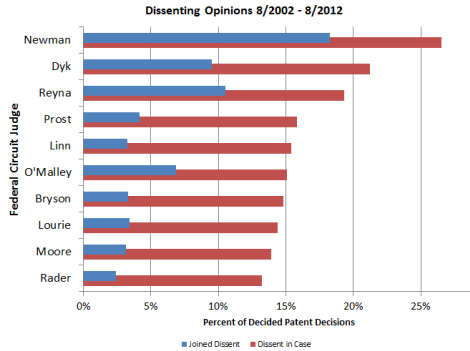The chart below is based upon an analysis of about 2,300 federal decisions that Westlaw classified as a “patent” decisions based upon the Westlaw Headnote. To make the chart, I tallied the number of times that each Federal Circuit judge was a panel member on a patent decision. Then, I looked to each of those decisions to identify whether a dissenting opinion was filed in the case. The red bar shows the results of this inquiry. Thus, about 27% of the patent decisions that include Judge Pauline Newman as a panel member include a dissenting opinion. Now, Judge Newman is in the majority in some of those cases and dissents in others. The blue bars represent the percent of cases where the given judge joined the dissent. Thus, Judge Newman joined the dissent in about 18% of the patent decisions where she was a panel member.

As is apparent from the chart, Judge Rader has the greatest frequency of being on a unanimous panel and, when there is a dissent, he is the least likely to to be the one dissenting. These are likely good qualities to have in a Chief Judge. Of course, these results primarily rely on decisions that came out before Judge Rader became Chief.
Of course, dissenting views at the Federal Circuit are particularly important because of the lack of other regional circuits deciding patent cases. Highlighting the ongoing debate in dissenting opinions cues attorneys to consider nuanced viewpoints. Dissents also help to highlight cases for the Supreme Court.
A few important caveats with the results.
- The search was limited to decisions released between 8/1/2002 and 8/1/2012 that are included in the Westlaw CTAF database and that had been provided with a headnote mentioning the term “patent.” This strategy includes all the major patent decisions and most non-precendential decisions with written opinions. It ordinarily excludes Rule 36 affirmances.
- The results include en banc decisions. These very often include dissenting opinions.
- The results include includes opinions classified as dissenting opinions by Westlaw. This includes in-part dissents as well as Judge Reyna's recent opinion dubitante.
- I included Judge Reyna and O'Malley in the results. However, their low decision total means that their results are not yet stable.
It is not news that Judge Newman is the most frequent dissenter on the Court of Appeals for the Federal Circuit. Gov't contracts attorney Stanfield Johnson recently penned an article titled “The Federal Circuit's Great Dissenter” in the area of government contract jurisprudence. In the view of Mr. Johnson, the dissents arise because Judge Newman is more likely than her colleagues to force the government to defend its actions.
Most often I find myself agreeing with Judge Newman more that with Judge Rader. Sometimes being a patent attorney can be helpful…
I’d be curious to know if there are any trends within Judge Newman’s dissents and/or the opinions she writes for the majority, e.g., are there are judges with whom Judge Newman disagrees with 100% of the time that they are on the same panel?
Both are experienced and thoughful judges. It almost appears that by “not yet stable” that their dissents have not yet been “normed” to what the groupthink wants.
No, I think “not yet stable” means that the sample size is too small to tell us whether the current percentages for these judges actually reflect a long term trend.
Further, Rader’s numbers are not appreciably different (within tenths of percent) than five other judges when looking at blue divided by red to arrive at a “disagree with others when disagree at all” view.
I’m curious to see your calculations, as I see a much larger difference than a few tenths of a percent. I may be looking at it wrong, but just estimating, I see about 2.4/13=.185, 3.2/14=.226, and 3.6/14.5=.248, for Rader, Moore, and Lourie, respectively. I read that as saying that when there is a dissent at all, Rader is quite a bit less likely than anyone else to be the person writing it. The question is whether those differences are statistically significant; I expect they are.
I am probably not alone in wondering: what do examiners prefer to summon?
“However, their low decision total means that their results are not yet stable.”
Both are experienced and thoughful judges. It almost appears that by “not yet stable” that their dissents have not yet been “normed” to what the groupthink wants. I don’t see either the value or the driver for wanting such groupthink.
“These are likely good qualities to have in a Chief Judge”
Why? Should a Chief Judge look for harmony, or should a Chief Judge look for ferreting out justice? One thing to consider is that without circuit splits to flesh out the best law, it is the dissents that serve this purpose. Especially if the dissents are articulate and well-reasoned, as most (but not all) of Judge Newman’s dissents are.
Further, Rader’s numbers are not appreciably different (within tenths of percent) than five other judges when looking at blue divided by red to arrive at a “disagree with others when disagree at all” view.
Either that or Rader picks his battles while Newman fights across the board…
One would think that Rader is leading the court in a direction that Newman does not approve. But that would be wrong because I think Rader in Newman agree on most issues.
But this seems to suggest is that Rader is more persuasive in getting other judges to vote his way.
Wow Newman dissents a lot.
I bet you guys didn’t know that inventors have their own demon to summon.
link to en.wikipedia.org
very nice site
classy
Comments are closed.